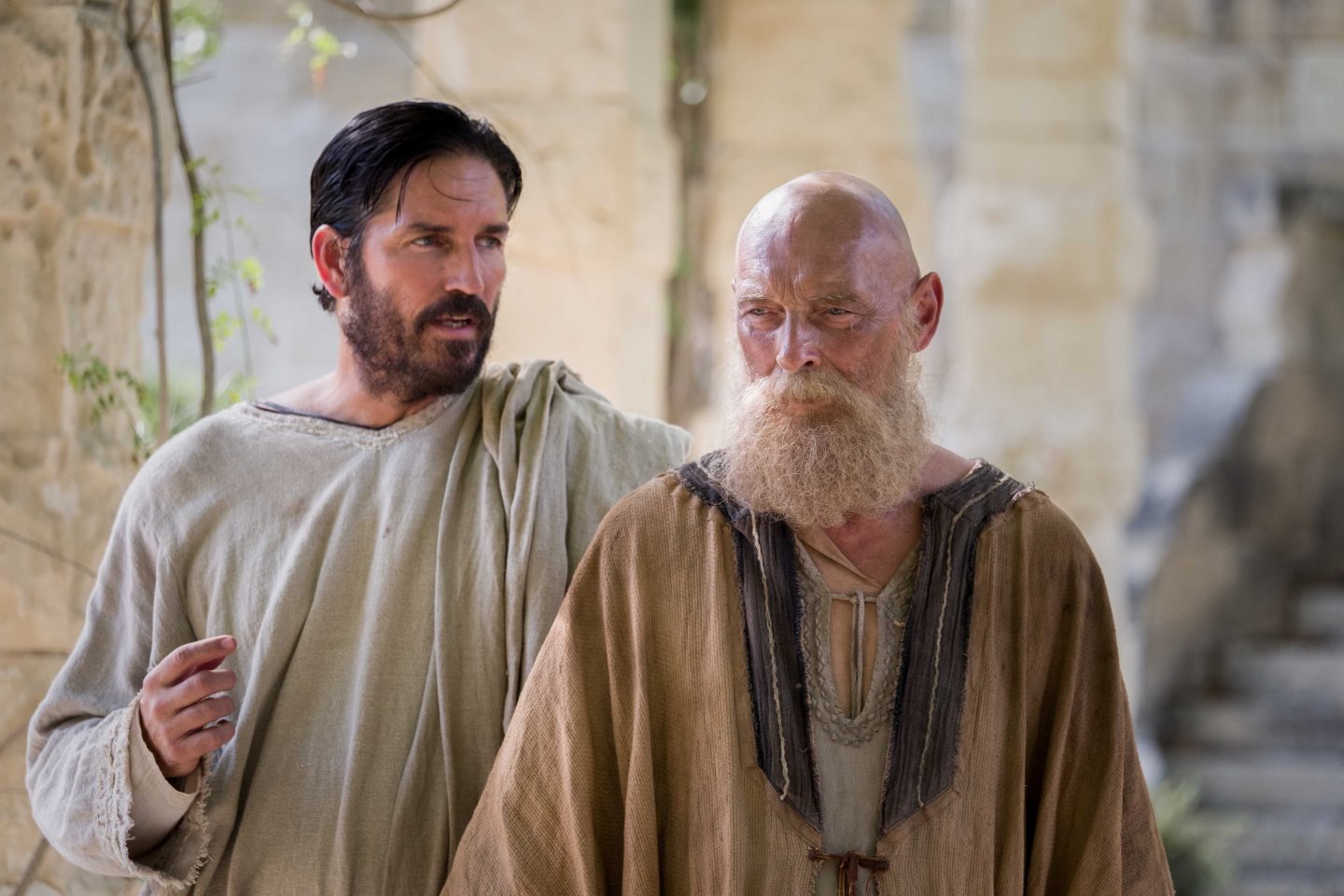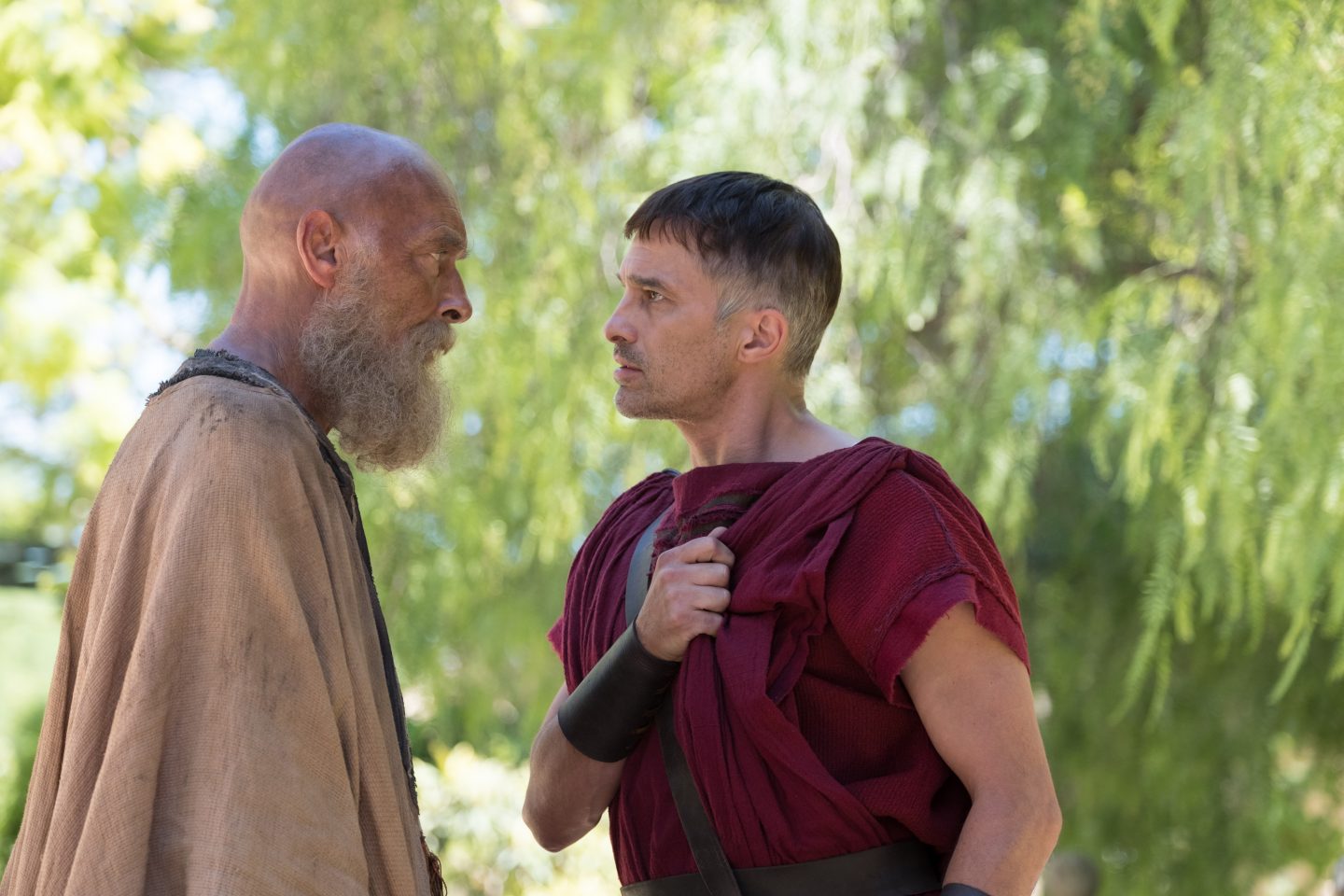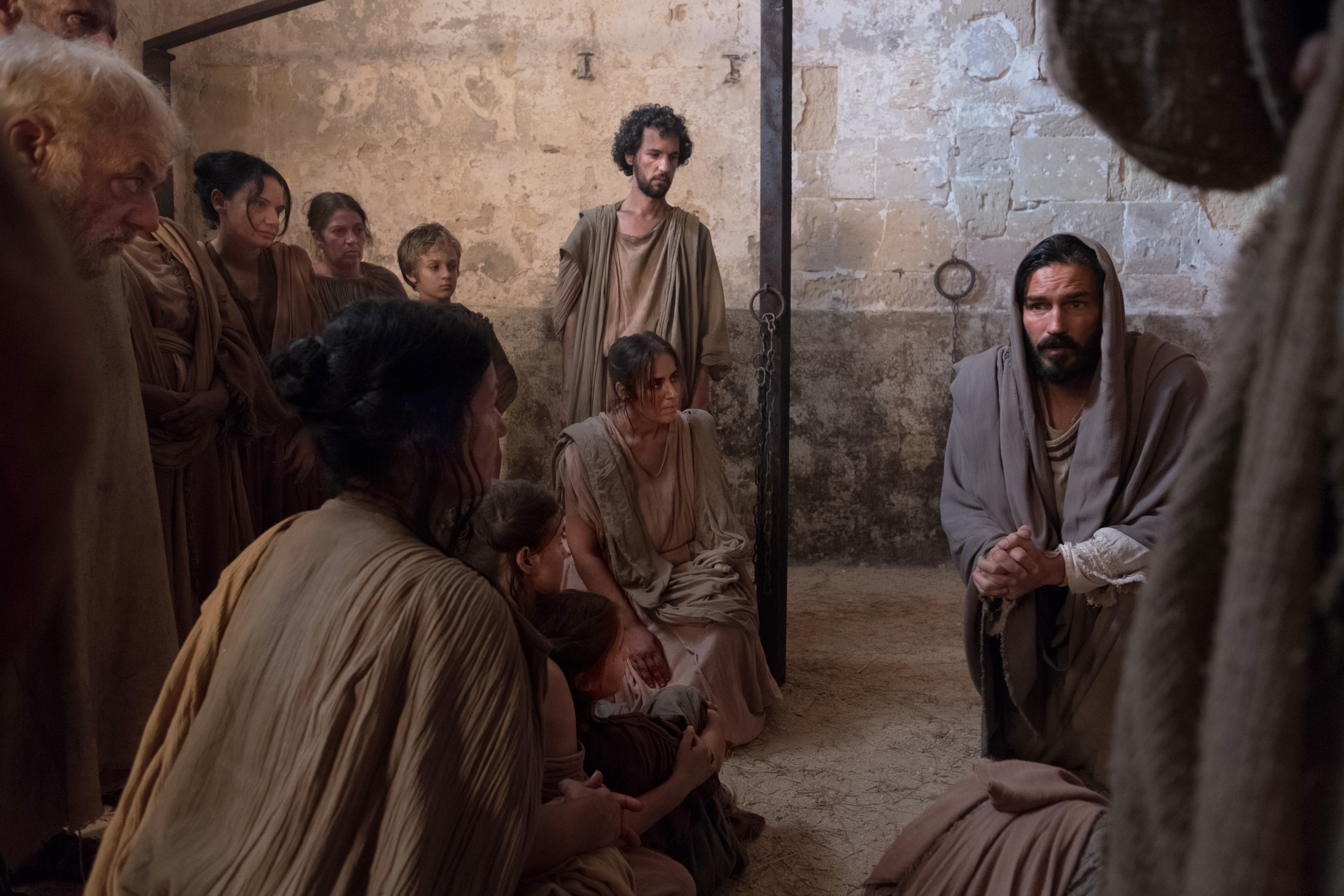
Luke (Jim Caviezel, left) visits Paul (James Faulkner) in prison during his last days. Photo by Affirm Films.
Paul, Apostle of Christ, is a movie that is steeped in darkness in more ways than one.
The latest production helmed by Sony Picture’s faith-based label, Affirm Films, the film is set during the iconic titular character’s last days in Rome.
In the first scene, the camera follows a mysterious figure, soon revealed to be the apostle Luke (played by Jim Caviezel, best known for his much lauded performance as Jesus in The Passion of the Christ). Under a shroud of darkness, Luke is trying to get to his destination unnoticed.
Roman soldiers are spotted either patrolling roads or abusing slaves. Streets are lit only by powerful flames, with humans burnt alive and used as torches. The first scene ends with a scream piercing through the sky, as the camera tilts up. So far, first century Rome is epitomising a dark, godless society.

Paul (left, played by James Faulkner) in an intense exchange with prison warden, Mauritius (Olivier Martinez). Photo by Affirm Films.
According to historians, that’s not too far off from real life. Following the commandment “thou shall have no other gods before me” (Exodus 20:2) was a life-and-death decision for the early Christians.
Romans considered them blasphemous for refusing to worship Roman gods, a rebellion that put their empire at peril. More importantly, the Christians refused to exalt the emperor, commonly seen as a divine figure.
Christians also became easy targets, which Nero took advantage of by blaming them for the Great Fire of Rome in AD 64. This led to early Roman Christians being killed and tortured in the most barbaric methods – crucified, covered in animal skin then torn apart by dogs, or used as human torches, as the film depicts.
In such violent times, the Roman Christians were in a precarious situation.
Conflict within the church was also an issue, as Paul’s letters in the Bible point out (1 Corinthians 3:3, Philippians 4:3). The film helps us to comprehend the danger that anxiety and strife within the church body brought.
(You may want to stop reading here if you are avoiding spoilers.)
Tumultuous times
In the movie, Priscilla (Joanne Whalley) and Aquila (John Lynch), have built a secret refuge for Christians in Rome, while news of other Christians being murdered keep pouring in.
Against the counsel of Priscilla and Aquila, Cassius (Alessandra Sperduti), a fictional young and hot-headed member of the community, tries to rescue Paul (James Faulkner) from prison and lead a rebellion as revenge against their persecution. Cassius’ disobedience leads to an ill-advised move that even Paul, caged up inside a damp dungeon, calls foolish and refuses to partake in.
Paul, Apostle of Christ highlights the persecution of Christians in the tumultuous days of the first church.
Meanwhile, the apostle Luke, risking his life, has come to Rome and snuck into Mamertine prison to convince the aged Paul to allow him to document his life and wisdom (second half of Acts, and the epistles).
Paul, who is Emperor Nero’s scapegoat for the Great Fire in the movie, is awaiting execution. As his final days draw near, recollections of his former life as Saul of Tarsus make him start doubting his salvation.
Luke is caught by the prison warden Mauritius (Olivier Martinez) who, intrigued by Luke’s determination to visit Paul, allows the nightly interactions to continue. Mauritius is also vexed by a personal plight – his daughter is bedridden by an unknown sickness, which has torn his family apart.
And so, despite its title, Paul, Apostle of Christ is a movie not so much about Paul’s road to redemption as much as an attempt to highlight the persecution of Christians in the tumultuous days of the first church. In fact, Paul does not turn up in the film until about fifteen minutes in.

Luke (Jim Caviezel) speaking to a group of Christians in hiding. Photo by Affirm Films.
For Christians, the film will strike a vivid chord. Watching the violence against early Christians is different from reading a book about Christian history, or even the Bible.
In one poignant scene, Luke stares from a corner as a man is tied to a pole while soldiers taunt him before setting him on fire. The scene cuts to Luke’s face as the man’s screams linger. To modern-day believers in Singapore, where we have the freedom to worship freely, the severe consequences early Christians faced for their faith is sobering.
It’s also a stark reminder about the necessity of suffering, especially during a time when the prosperity gospel still has its followers.
Talking to Luke, Paul says at one point that “Christ has promised these difficult times” but he “sees the joy of where I’m going to go”, a reference to John 16:33 and Mark 10:29-30.
Christianity isn’t about the hope for material blessings, but for what is “laid up” for us “in heaven” Colossians 1:5.
Sorrowful, yet rejoicing
Despite their controversy, movies such as The Passion of the Christ and The Last Temptation of Christ help us confront the intense suffering Christ went through at the cross.
Likewise, in Paul, Apostle of Christ, we are given a visual of the Bible’s most influential apostle living out the verse “as sorrowful, yet always rejoicing” (2 Corinthians 6:10) in his final days, scarred and emaciated.
We see the Bible’s most influential apostle living out the verse “as sorrowful, yet always rejoicing” in his final days, scarred and emaciated.
Like The Case for Christ, this movie is a sincere attempt at quelling the prejudices against poorly conceived, poorly produced Christian films. Under the hands of cinematographer Geraldo Madrazo, what emerges are gritty and grim-looking visuals as opposed to bright and sterilised shots.
Scripture such as “his ways are not my ways” (a paraphrase of Isaiah 55:8), is smoothly weaved into the story, mostly through Paul’s dialogue. (The lines don’t seem out of place when they are spoken through a man with a thick, white beard.)
On the other hand, this movie may not be a helpful tool for evangelism. It expects moviegoers to have a basic understanding of who the main characters are.
Besides hazy flashbacks of Paul’s time as Saul, murdering Christians before Jesus blinded and spoke to him, there is little to help the audience understand Luke’s zealousness, or why Paul is highly regarded among Christians.
The storyline, with its multitude of subplots – from Priscilla and Aquila’s contention about whether they should escape from Rome, to Mauritius’ family drama – may leave some viewers at a loss over the focus of the film. It also fails to leave room for the audience to connect with any of the characters, who seem to always be yelling, weeping, or speaking in a whisper.
Instead, perhaps the value of the film lies in its cinematic depiction of hardship and deep faith – timely as we reflect on Jesus’ sacrifice as Easter draws near.
Paul, Apostle of Christ will be playing in local cinemas from March 22, 2018 onwards. For tickets, please visit Salt Media & Entertainment.
We are an independent, non-profit organisation that relies on the generosity of our readers, such as yourself, to continue serving the kingdom. Every dollar donated goes directly back into our editorial coverage.
Would you consider partnering with us in our kingdom work by supporting us financially, either as a one-off donation, or a recurring pledge?
Support Salt&Light

